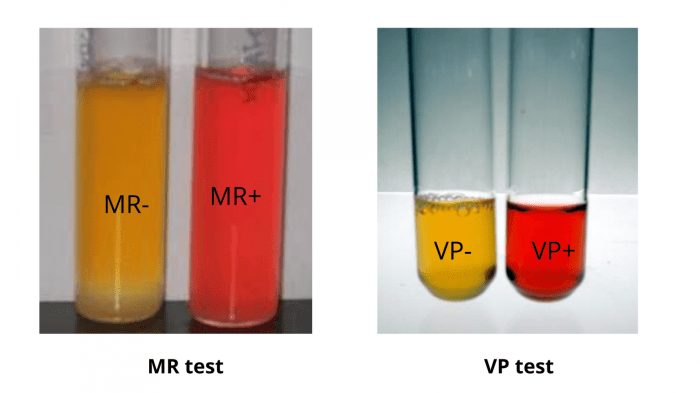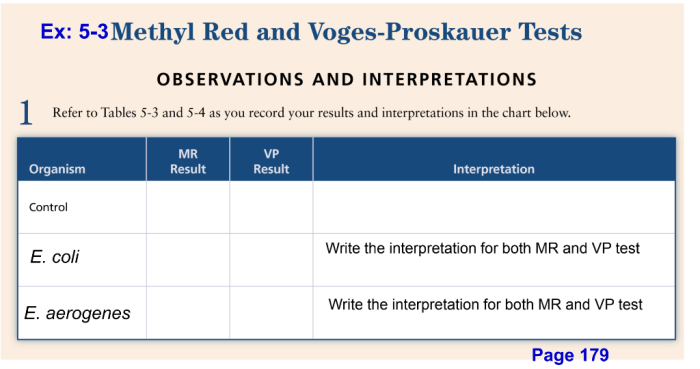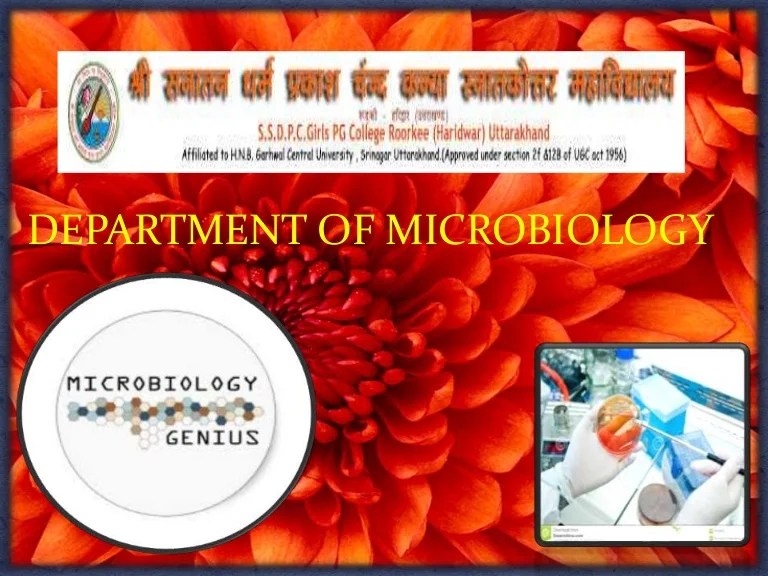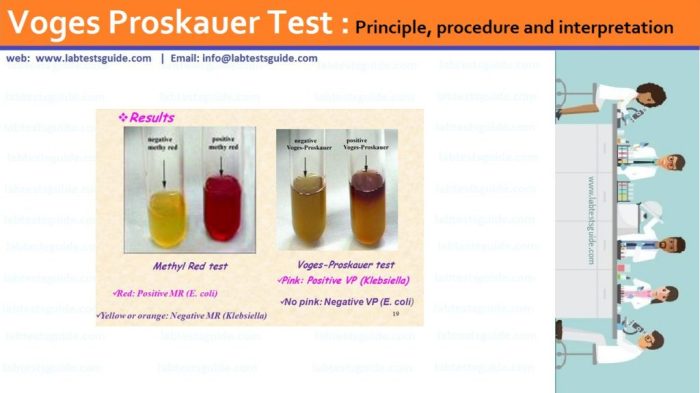Methyl red and Voges-Proskauer tests are two fundamental techniques in microbiology that play a crucial role in differentiating bacterial species. These tests exploit distinct metabolic pathways to provide valuable insights into the biochemical capabilities of bacteria, aiding in their identification and characterization.
The methyl red test evaluates a bacterium’s ability to ferment glucose through the mixed acid fermentation pathway, while the Voges-Proskauer test assesses its capacity for butanediol fermentation. By examining the end products of these metabolic processes, these tests offer a window into the specific metabolic capabilities of different bacteria.
Methyl Red Test

The methyl red test is a qualitative test used to differentiate between bacteria that ferment glucose with the production of acid end products (acid fermentation) and those that produce neutral end products (neutral fermentation).
The test is based on the ability of the indicator methyl red to change color in response to the pH of the medium. In acidic conditions, methyl red is red, while in alkaline conditions, it is yellow.
Chemical Reaction
The chemical reaction that occurs in the methyl red test is as follows:
C15H 15N 3O 2+ H +→ C 15H 15N 3O 2H +
In this reaction, methyl red (C 15H 15N 3O 2) reacts with a proton (H +) to form the protonated form of methyl red (C 15H 15N 3O 2H +). The protonated form of methyl red is red in color.
Interpretation
The interpretation of the methyl red test results is as follows:
- If the medium is red, the bacteria is positive for the methyl red test. This indicates that the bacteria produces acid end products during glucose fermentation.
- If the medium is yellow, the bacteria is negative for the methyl red test. This indicates that the bacteria produces neutral end products during glucose fermentation.
Voges-Proskauer Test

The Voges-Proskauer test is a biochemical test used to differentiate between bacteria based on their ability to produce acetoin from glucose.
Chemical Reaction
The test involves the addition of alpha-naphthol and potassium hydroxide to a bacterial culture. If acetoin is present, it reacts with the alpha-naphthol to form a red complex. The presence of this complex indicates a positive Voges-Proskauer test.
Interpretation of Results, Methyl red and voges-proskauer tests
- Positive Result:A red color indicates the presence of acetoin and is associated with bacteria that ferment glucose via the butanediol pathway.
- Negative Result:A yellow or colorless solution indicates the absence of acetoin and is associated with bacteria that ferment glucose via the mixed acid fermentation pathway.
Comparison of Methyl Red and Voges-Proskauer Tests

The Methyl Red (MR) and Voges-Proskauer (VP) tests are two biochemical tests used to differentiate bacteria based on their metabolic pathways. While both tests involve fermentation of glucose, they differ in their specific purposes, chemical reactions, and interpretation of results.
The MR test determines the ability of bacteria to produce and maintain an acidic environment during glucose fermentation. A positive MR test indicates the production of significant amounts of acid, resulting in a red color change in the indicator dye methyl red.
In contrast, a negative MR test suggests that the bacteria produce less acid or utilize alternative metabolic pathways, resulting in a yellow color.
Chemical Reactions
The chemical reactions involved in the MR and VP tests are distinct. In the MR test, glucose is fermented via the mixed acid fermentation pathway, producing various organic acids, including lactic acid, acetic acid, and formic acid. These acids accumulate in the culture medium, lowering the pH and causing the methyl red indicator to turn red.
In the VP test, glucose is fermented via the 2,3-butanediol fermentation pathway, producing acetoin as an intermediate. Acetoin is then oxidized to diacetyl by atmospheric oxygen. Diacetyl reacts with creatine and α-naphthol in the VP reagent to form a red-colored complex.
Interpretation of Results, Methyl red and voges-proskauer tests
The interpretation of MR and VP test results aids in the identification and classification of bacteria. A positive MR test (red color) indicates that the bacteria can produce and maintain an acidic environment, while a negative MR test (yellow color) suggests alternative metabolic pathways or reduced acid production.
A positive VP test (red color) indicates the production of acetoin and diacetyl, while a negative VP test (yellow or brown color) suggests that the bacteria do not produce these compounds or lack the necessary enzymes for the 2,3-butanediol fermentation pathway.
Applications of Methyl Red and Voges-Proskauer Tests

The methyl red and Voges-Proskauer tests are important tools in microbiology for identifying different types of bacteria. These tests are based on the ability of bacteria to ferment glucose and produce different end products.
Applications of Methyl Red Test
The methyl red test is used to differentiate between bacteria that produce mixed acids (such as Escherichia coli) and those that produce mainly lactic acid (such as Lactobacillus). The test is based on the ability of bacteria to produce a red color when a methyl red indicator is added to a culture that has been fermented with glucose.
- Bacteria that produce mixed acids will turn the methyl red indicator red, while bacteria that produce mainly lactic acid will not.
- The methyl red test is used to identify bacteria that are members of the family Enterobacteriaceae.
Applications of Voges-Proskauer Test
The Voges-Proskauer test is used to differentiate between bacteria that produce acetoin (such as Enterobacter) and those that do not (such as Salmonella). The test is based on the ability of acetoin to react with α-naphthol and potassium hydroxide to produce a red color.
- Bacteria that produce acetoin will turn the Voges-Proskauer indicator red, while bacteria that do not produce acetoin will not.
- The Voges-Proskauer test is used to identify bacteria that are members of the family Enterobacteriaceae.
Clarifying Questions: Methyl Red And Voges-proskauer Tests
What is the purpose of the methyl red test?
The methyl red test determines a bacterium’s ability to produce and accumulate acidic end products during glucose fermentation.
How is the Voges-Proskauer test performed?
The Voges-Proskauer test involves incubating a bacterial culture in a medium containing glucose and observing the production of a pink color, indicating a positive result.
What is the significance of a positive Voges-Proskauer test?
A positive Voges-Proskauer test indicates that the bacterium can ferment glucose via the butanediol fermentation pathway, producing butanediol as a major end product.

